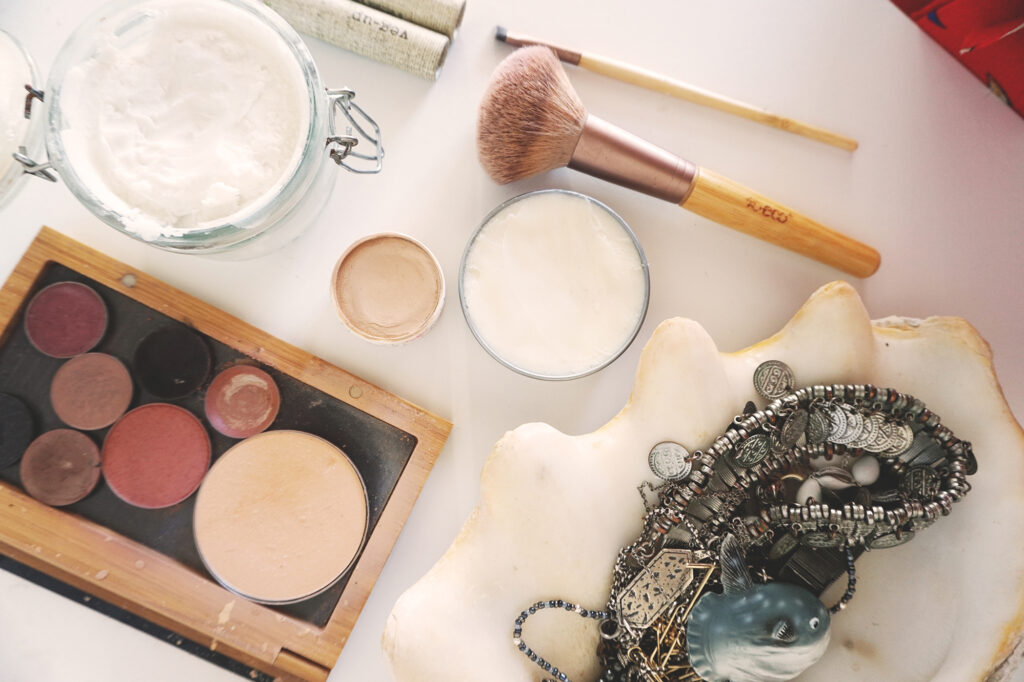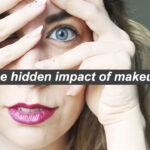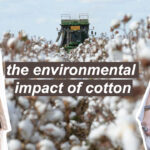Cosmetics and personal care are some of the most universal products in the world. The average American uses between 7-12 different care products every day. Cosmetic companies have said to be able to sell their products anywhere in the world and to most demographics. Worldwide the cosmetics and personal care products industry has more than $250 billion in annual retail sales. With a type of product being so widely consumed, I have always had some concerns regarding both the production and the disposal of it. Right off the bat, I also see a lot of packaging. From a zero waste perspective, I haven’t supported big cosmetic companies for years at this point, and I have made tons of videos about how to make your own makeup products, my favourite zero waste beauty essentials, plastic-free get ready with me videos, all this stuff is already here. What’s left is actually talking about the detrimental effects of conventional makeup, so that’s what this video is about. The environmental impact of makeup can be divided into 3 categories which will we all covered in this video. The categories are packaging, contents, and production.
Let’s take a look at the packaging. The majority of makeup products come in plastic packaging, or with plastic components in its packaging. Some products also come in cardboard but the cardboard is often unrecyclable because it is either mixed with plastic for a shiny finish or it is covered in glue to keep everything in place. In some rare cases, brands will make you able to sort the packaging and recycle some components but that’s mostly something I’ve seen from eco brands. A lot of a product’s value, price, and selling point, also comes from beautiful packaging, which often means many that resources have gone into making it. Furthermore, most packaging is single-use (with the exception of a couple of refill initiatives here and there which is great). And what happens to most single-use packaging? It ends up in landfill and in landfills, trash will never break down because there is no air to decomposition once more trash is piled on top. Actually about 70% of cosmetic products end up in landfills unfinished. The plastic packaging from cosmetics has the exact same impact as any other plastic product. The production of petroleum-based plastic emits staggering amounts of co2 and methane, plastic can only be recycled 1-3 times, the global recycling rate for plastic is about 9% and plastic in nature and the oceans pose a big threat to ecosystems, wildlife and even ourselves.

ALSO WATCH: 10 LOW WASTE TIPS FOR MAKEUP LOVERS
Now let’s take a look at contents. And the best way to do that is by talking about The Dirty Dozen. The Dirty Dozen is a list of 12 chemicals and toxins that you can find in many household and beauty products, but what makes them dirty is the fact that they are extremely harmful, both to you and to the environment (generally most things that are bad for you aren’t pals of the environment I guess). Here is the list:
1. BHA (butylated hydroxyanisole) and BHT (butylated hydroxytoluene) /2. Coal tar dyes: p-phenylenediamine and colours listed as “CI” followed by a five-digit number / 3. Diethanolamine (DEA), cocamide DEA, and lauramide DEA / 4. Dibutyl phthalate (DBP) / 5. Formaldehyde-releasing preservatives / 6. Parabens / 7. Parfum (aka fragrance) / 8. Polyethylene glycol (PEG) / 9. Petrolatum (aka petroleum jelly or Vaseline) / 10. Siloxanes / 11. Sodium laureth sulfate / 12. Triclosan

ALSO WATCH: 20 ZERO WASTE BEAUTY TIPS // skin, hair, makeup, nails & teeth
If you want to know more about one of these specific toxins and what they do (pssst cancer, hormone disruption, fun stuff), I have a link to a webpage that goes into way more detail with each and every one. The gist is that these aren’t great and one of the reasons why is because when we use products with these ingredients they end up being flushed down the drain where they bioaccumulate. This is a fancy way of saying that they are not dissolving and biodegrading, they build up because they are synthetics that have no methods of breaking down when they get out into water systems. This happens every time we shower, go into the ocean wearing products, or rinse our makeup off. But are these Dirty Dozen in a lot of products? Heck yeah. More than 6,200 individuals participated in a survey in Canada, providing information for more than 12,500 personal care products. The results are disturbing: Almost 80 per cent of products reportedly contained at least one of the Dirty Dozen ingredients; more than half of all products reportedly contained multiple Dirty Dozen ingredients; Participants were unable to locate ingredient lists on more than 1,000 products. Some products contain up to seven of these dirty dozen, a few of them are Lancome Photogenic Foundation, Rimmel Lasting Finish Foundation, Estee Lauder lipsticks, and Maybelline’s Perfect Fit Me.
Honestly, I never cared too much about what I put in my body, I had vegan onion rings for breakfast and my body is a garbage bin so what’s one or two of the dirty dozen? Well, you won’t necessarily see any sudden effects when using that lipstick you got of Wish, but over time these toxins build up and can cause chronic illness, allergies, and hormonal issues. But my number 1 concern is not my garbage bin body, it’s mother earth we gotta treat her right. 700,000 tons of pollutants are released daily partly from household cleaning products, partly from cosmetics and partly from hair dyes. AND when these toxins leave your household they not only end up in water systems, they also affect the soil we use to grow crops, which ultimately brings the issues back into our homes. The University of Gothenburg reported that even chemicals from cosmetics that are harmless when isolated can react is hazardous ways when they end up in the oceans because they react with other chemical compounds.

ALSO WATCH: TOP 10 ZERO WASTE BEAUTY/CARE PRODUCTS
It is becoming general knowledge that synthetics, chemicals (everything is a chemical tho), toxins are bad. So on the other end of the spectrum, cosmetic companies are cashing in on the use of words like “organic” and “natural”. Because consumers react very well to the use of these words, but often it turns out to be greenwashing. I also have an issue with the use of “natural” as a selling point in general, because it does not necessarily mean that a product is good. Here is what the FDA has stated regarding natural ingredients: In fact, natural ingredients may be harder to preserve against microbial contamination and growth than synthetic raw materials.” “Additionally, the FDA has stated, “consumers should not necessarily assume that an organic or natural ingredient or product would possess greater inherent safety than another chemically identical version of the same ingredient.” As a consumer, it’s important to be critical. I have seen countless brands promote themselves as “natural” because there is honey, or vegetable oil or coconut in their products, what they forget to mention is the 7 Dirty Dozen ingredients they’ve also added. So 1 “natural” ingredients are often a green alibi for the rest of the garbage.
There is another thing that I HAVE to mention. I’ve talked about this in other videos as well, but it just bugs me a lot, so here goes. Glitter is plastic. So many cosmetic products contain glitter and when we rinse that makeup off we flush micro plastic directly out into nature. So why not use a natural and biodegradable glitter alternative? Many cosmetic products contain mica as a natural substitute for glitter, a glittery substance used in blusher, eyeliner, eye shadow, mascara, lipstick, and foundation.

ALSO WATCH: 20 wasteful beauty/fashion items you don’t need anymore
Today the main source of this mineral comes from India. India accounts for 60% of global production and possesses an industry that is estimated to have grown by 8.5% during the last two years. Furthermore, child labour is a giant issue in India’s mica mining business and 86% of the country’s mica exports in are basically unregulated. Children in the Indian mica industry make less than a quarter a day and they risk their lives in the unregulated mines to provide the minerals for the western market. In comparison, a Chanel highlighter with natural mica costs about 60 dollars. It is ironic that people in resource and mineral-rich areas many places in the world are also some of those most affected by poverty. This is due to human exploitation and corruption, so the industry that buys the mica is not productively building a community, it’s breaking it down. Child labour is a problem in many industries and just like those, the “regulation” to avoid children in forced labour is corrupt and inefficient. Bigger western companies often pay the factory to inspect themselves which means that a lot of forced labour goes by undetected. You can, of course, make the argument that bad things happen in every industry, and for the most part that is true, I think it is worth considering where we get out mica from, especially because it is such an unnecessary product. Lush has declared they are going to phase out natural mica in favour of lab-grown mica.

ALSO WATCH: ZERO WASTE SHOWER ROUTINE // skin & hair care
I also reeeally want to put it out there that many children affected by child labour do not have the option or the privilege to choose. Many would simply starve if they did not work. So it’s only about “boycotting all mica” it’s about pushing the brands towards ethical sources so the brands that buy the mineral also help build the community, provide safety and education to the children who work that currently do not have any other choice. I am not saying that I am pro-child labour here, but I am pro-child.
Another ingredient that is “natural” but often horrible to the environment is palm oil. Its intense production causes deforestation and loss of habitat for important wildlife. Palm oil is the most utilized vegetable oil in the world and I have already made a video about it. The video focuses a lot on palm oil in food, but actually, it is a very common ingredient in beauty and care products as well. So this is definitely something to look out for and avoid when possible.

ALSO WATCH: LOW IMPACT GLOW UP // get ready for new year’s eve with me!
Lastly, we have production, which I guess the mica issues also fall under because it speaks to how many cosmetic companies choose not to prioritize human rights over sparkles.
But there are other aspects of the production of cosmetics which I think are important to mention. One of which is animal testing. Over 100 million animals are burned, crippled, poisoned, and abused in US labs every year. But we have the technology to phase out animal testing, which luckily is happening many places already, and it has been proven that animal testing has virtually become useless since many effects that cosmetics may have on animals almost never occurred in humans.
Another issue I have with the production of cosmetics is the scale. We buy a lot of it when more and more is being produced. Much more than we need in fact. I think there it is extremely problematic that so many brands and celebrities are launching extensive makeup lines and huge palettes, lots of YouTubers are going it as well and it rubs me the wrong way. The reason why palettes especially bug me is that the consumer can seldom choose the colours for themselves, so when we want to support your favourite YouTuber we buy the colour they pick for us. Often we end up using some of the colour but rarely all of them and as a result, a lot of product is going to waste. I love it when brands make the single refills for a palette available so we don’t have to buy 24 colours just to get the 4 we like.

ALSO WATCH: MAKING LIPSTICK FROM BEETS // homemade zero waste beauty
An issue that is visible through all of these aspects is the lack of transparency, which makes it very hard to make conscious decisions for the consumers.
15 tips for sustainable makeup use:
- Rely on refill policies and options rather than buying new packaging
- Avoid big palettes and products that include shades you’re never going to use
- Build your own palette with single shades (often comes with simple cardboard packaging)
- Choose brands that don’t test on animals
- Choose brands that avoid the Dirty Dozen
- Never buy a product with no ingredients list
- Avoid knock-off products as their ingredients are often much less regulated than the originals
- Have a few shades you can mix and blend rather than buying 3 times as many
- Don’t buy products from cheap sellers on Ebay or Wish
- Check for palm oil use
- Find out something about the brand you’re buying from and if they have any sustainability certification
- Boycott plastic-based glitter and sparkles
- Support brands that actively take a stance for ethically sourced, or lab grown mica
- Choose products with reusable and recyclable packaging so it does not end up in landfill
- Switch out liquids products like shampoo and conditioner with solid soap bars to reduce plastic.





